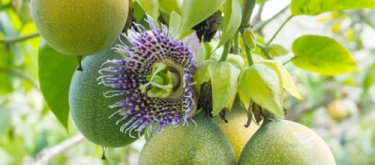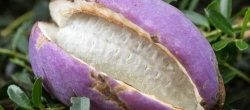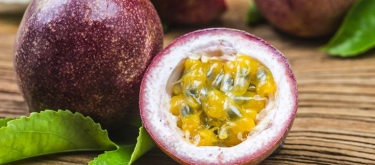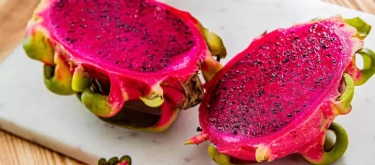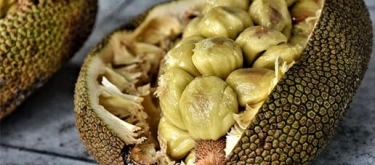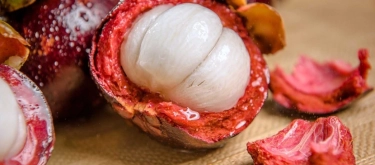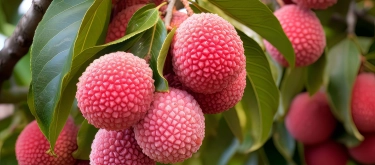Granadilla: Taste Profile, Aroma, Benefits and Health Risks
Granadilla, often referred to as the sweet passion fruit, is a tropical delight belonging to the passion flower family (Passiflora ligularis). Renowned for its mildly sweet flavor, refreshing tang, and appealing texture, granadilla has become increasingly popular among health-conscious food enthusiasts and adventurous cooks alike. Its smooth, jelly-like pulp encases a crunchy array of edible seeds, all wrapped in a vibrant, edible outer skin. This article delves into the sensory attributes of granadilla, offering an in-depth flavor analysis, exploring its culinary applications, nutritional benefits, and providing practical tips on selection and storage, along with guidance on how best to enjoy this remarkable fruit and potential cautions.
What does Granadilla taste like?

Taste, Aroma, Texture, and Visual Appearance
Taste:
Granadilla presents a delicate balance between natural sweetness and a subtle tang.
- Flavor Description: The initial flavor burst is sweet and refreshing, reminiscent of a gentle mix between citrus and tropical melon, with a nuanced tang that enlivens the palate without overpowering it.
Aroma:
The aroma of granadilla is light, fragrant, and inviting.
- Aromatic Description: It offers a clean, mildly floral scent with hints of tropical fruit and citrus, evoking images of sun-drenched orchards and warm, breezy afternoons.
Texture:
Texture is a standout feature of granadilla that enhances its overall appeal.
- Texture Description: The fruit’s pulp is smooth, gelatinous, and refreshingly juicy, interspersed with small, crunchy seeds that provide a pleasant textural contrast.
Visual Appearance:
Granadilla is as visually striking as it is flavorful.
- Visual Description: Typically, the fruit exhibits a vibrant, bright orange exterior that can be eaten along with the tender, translucent pulp inside. Its naturally glossy, uniform skin and the vivid color of the pulp make granadilla an eye-catching addition to any fruit platter.
In-depth Flavor Analysis of Granadilla
The complex flavor of granadilla is shaped by its natural composition and the ripening process:
- Sugar-Acid Equilibrium:
Natural sugars in granadilla offer a delicate sweetness that is elegantly balanced by mild organic acids, such as citric acid. This balance results in a refreshing, well-rounded taste that is both sweet and tangy. - Subtle Complexity:
Alongside its primary flavors, granadilla carries gentle hints of tropical melon and citrus, with a whisper of floral notes that add depth and complexity. - Impact of Ripeness:
Optimal ripeness is key; a perfectly ripe granadilla provides a harmonious blend of sweetness and tang, whereas underripe fruits may taste overly tart and firm, and overripe ones can lose their crisp texture. - Synergistic Development:
The interplay of these flavor elements produces a multi-dimensional taste experience that is both refreshing and sophisticated.
Culinary Applications of Granadilla
- Primary Uses:
Granadilla’s versatility makes it a delightful ingredient in a variety of dishes. - Popular Applications:
- Fresh Consumption: Enjoy granadilla on its own as a refreshing, nutrient-rich snack.
- Fruit Salads: Add sliced granadilla to mixed fruit salads for a burst of tropical flavor and vibrant color.
- Smoothies and Juices: Blend granadilla with other fruits for a naturally sweet, hydrating beverage.
- Desserts: Use granadilla as a topping for yogurt, ice cream, or in sorbets and tarts to introduce a unique tropical twist.
- Fusion Dishes: Incorporate granadilla into savory salsas or salads to add a delicate balance of sweetness and tang.
- Ideal Pairings:
Granadilla pairs wonderfully with other citrus fruits, tropical berries, mint, and light dairy products, creating a harmonious blend that enhances both sweet and savory dishes.
Selection and Storage of Granadilla
- Selecting Granadilla:
Look for granadilla with a vibrant, glossy exterior that is slightly soft to the touch, indicating optimal ripeness. The skin should be free of blemishes, and the fruit should emit a fresh, fruity aroma. - Storage Recommendations:
Unripe granadilla can be kept at room temperature to continue ripening. Once ripe, store it in the refrigerator in a sealed container to maintain its crisp texture and vibrant flavor. For longer storage, consider peeling and slicing the fruit before freezing for later use in smoothies or desserts.
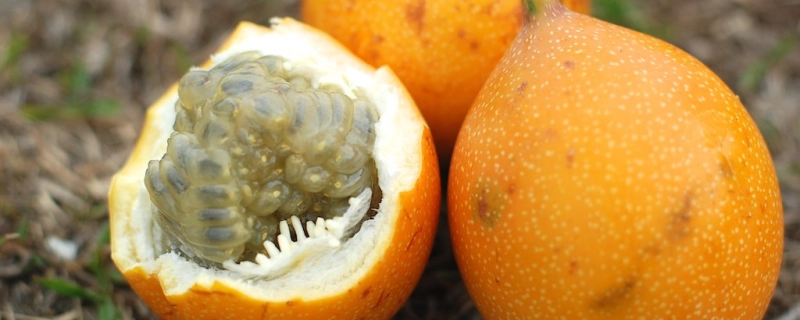
Quick Facts About Granadilla
- Exotic Origin:
Granadilla, also known as sweet passion fruit, originates from tropical regions of the Americas and is widely cultivated in Southeast Asia. - Distinctive Appearance:
Recognizable by its vibrant, edible orange skin and translucent, juicy pulp filled with crunchy seeds. - Nutrient-Rich:
Packed with vitamin C, dietary fiber, and antioxidants, granadilla supports a healthy diet. - Low-Calorie:
A refreshing, low-calorie option that is ideal for weight management. - Versatile Ingredient:
Suitable for fresh consumption, beverages, desserts, and fusion culinary creations. - Refreshing Flavor:
Offers a balanced mix of sweetness and tang that is both invigorating and sophisticated. - Hydrating:
High water content aids in hydration. - Global Appeal:
Increasingly popular among health-conscious consumers and food enthusiasts around the world.
Benefits of Granadilla
- Boosts Immunity:
Rich in vitamin C, granadilla supports immune function and enhances skin health. - Antioxidant Power:
Abundant antioxidants help combat oxidative stress and reduce inflammation. - Digestive Health:
Dietary fiber promotes healthy digestion and aids in maintaining gut health. - Low-Calorie Energy:
Provides natural sugars for a quick, sustained energy boost without excessive calories. - Hydration:
Its high water content contributes to maintaining proper hydration levels. - Nutrient-Dense:
Offers a blend of essential vitamins and minerals that support overall wellness. - Heart Health:
Potassium in granadilla helps regulate blood pressure and supports cardiovascular health. - Versatile Culinary Use:
Its balanced flavor profile makes granadilla adaptable to a wide variety of dishes.
Additional Nutritional Insights and Unique Varietal Details
- Core Composition:
Granadilla is primarily composed of water, natural sugars, and dietary fiber, which contribute to its hydrating and low-calorie nature. - Caloric Content:
On average, 100 grams of granadilla provide approximately 40–50 calories, making it an excellent, light snack. - Micronutrient Profile:
Rich in vitamin C, potassium, and B vitamins, granadilla supports immune function, metabolism, and cardiovascular health. - Dietary Fiber:
The fiber in granadilla aids digestion and helps maintain stable blood sugar levels. - Varietal Differences:
Different cultivars offer subtle variations in flavor intensity—some may be sweeter while others present a slightly more tangy profile. - Enzymatic Activity:
Natural enzymes present in granadilla assist in the breakdown of carbohydrates, enhancing digestibility. - Antioxidant Capacity:
High levels of antioxidants, particularly polyphenols and vitamin C, protect cells from oxidative damage. - Culinary Innovation:
Modern chefs are integrating granadilla into diverse recipes, from tropical fruit salads and refreshing smoothies to inventive desserts and fusion dishes.
How to Eat Granadilla
- Fresh and Whole:
Simply wash the granadilla, slice it in half, and scoop out the juicy pulp with a spoon. - Fruit Salads:
Add sliced granadilla to a mixed fruit salad for a burst of tropical flavor and a visually appealing twist. - Smoothies and Juices:
Blend the pulp with other fruits to create a refreshing, nutrient-rich beverage. - Dessert Topping:
Use granadilla as a topping for yogurt, ice cream, or fruit-based tarts to add a unique, tangy-sweet note. - Chilled Snack:
Enjoy granadilla chilled on its own as a hydrating and low-calorie treat. - Garnish:
Use granadilla slices to garnish desserts or savory dishes, adding both flavor and visual appeal.
Harm (Potential Negative Effects) of Granadilla
- Oxalate Content:
Granadilla contains moderate levels of oxalates, which could contribute to kidney stone formation in susceptible individuals. - Digestive Sensitivity:
Overconsumption, due to its high fiber content, might lead to digestive discomfort such as bloating or stomach upset. - Allergic Reactions:
Although rare, some individuals may experience allergic reactions, including itching or swelling, when consuming granadilla. - Pesticide Residues:
Non-organic granadilla may contain pesticide residues; thorough washing or opting for organic fruit is recommended. - Acidity:
The natural acids in granadilla could cause discomfort for individuals with sensitive stomachs or acid reflux if consumed in large amounts. - Caloric Considerations:
Despite being low in calories, consuming large quantities could contribute to an increased overall caloric intake.
Conclusion
Granadilla, the sweet passion fruit, offers a refreshing, low-calorie tropical experience with its balanced blend of natural sweetness and tang, crisp yet hydrating texture, and vibrant, eye-catching appearance. Rich in vitamin C, antioxidants, and dietary fiber, granadilla supports immune function, digestion, and overall wellness while providing a versatile ingredient for a variety of culinary creations. Whether enjoyed fresh, blended into smoothies, or incorporated into innovative dishes, granadilla enhances both the taste and nutritional value of your meals.
References
- Nguyen, T. & Chen, L. (2018). Exotic Fruits of Asia: Nutritional and Culinary Perspectives. Singapore: Tropical Press.
- Wong, A. (2019). "Nutritional Analysis of Tropical Fruits and Their Health Benefits." Journal of Tropical Agriculture, 11(3), 98–105.
- Smith, J. (2017). The World of Tropical Fruits: From Orchard to Table. New York: Global Fruit Press.
- Brown, A. & Lee, S. (2020). "Antioxidant Properties and Nutritional Benefits in Exotic Fruits." International Journal of Nutritional Studies, 12(2), 112–120.
- Garcia, P. (2018). Tropical Delights: A Guide to Exotic Fruits. London: Culinary Innovation Press.
- Martinez, R. (2019). "Long-term Nutritional Impacts of Tropical Fruits in Modern Diets." Journal of Food Science and Technology, 14(1), 78–85.
- Kim, S. (2020). "Dietary Fiber and Micronutrient Profiles in Tropical Fruits." Food Chemistry Research, 15(3), 89–97.
- Anderson, D. & Gupta, R. (2021). The Encyclopedia of Exotic Fruits. Los Angeles: Global Food Press.
